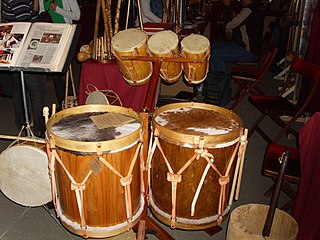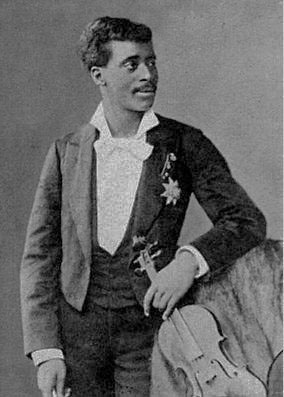Related Research Articles
The music of Cuba, including its instruments, performance, and dance, comprises a large set of unique traditions influenced mostly by west African and European music. Due to the syncretic nature of most of its genres, Cuban music is often considered one of the richest and most influential regional music in the world. For instance, the son cubano merges an adapted Spanish guitar (tres), melody, harmony, and lyrical traditions with Afro-Cuban percussion and rhythms. Almost nothing remains of the original native traditions, since the native population was exterminated in the 16th century.
Orquesta Aragón is a Cuban musical band formed on 30 September 1939, by Orestes Aragón Cantero in Cienfuegos, Cuba. The band originally had the name Ritmica 39, then Ritmica Aragón before settling on its final form. Though they did not create the Cha-cha-cha, they were arguably the best charanga in Cuba during the 1950s and 1960s. Their trade-marks included high-class instrumentalists playing in tight ensemble style, and rhythmical innovations which kept their sound up to date. Over the years they progressed from their start as a danzoneria to play a wider variety of styles, danzón, then cha-cha-cha, then onda-cha, pachanga and son fusions. They still perform today, based in Havana.
The guaracha is a genre of music that originated in Cuba, of rapid tempo and comic or picaresque lyrics. The word has been used in this sense at least since the late 18th and early 19th century. Guarachas were played and sung in musical theatres and in working-class dance salons. They became an integral part of bufo comic theatre in the mid-19th century. During the later 19th and the early 20th century the guaracha was a favourite musical form in the brothels of Havana. The guaracha survives today in the repertoires of some trova musicians, conjuntos and Cuban-style big bands.

Omar Sosa is a jazz pianist from Cuba.

Enrique Jorrín was a Cuban charanga violinist, composer and music director. He is considered the inventor of the cha-cha-chá, a popular style of ballroom music derived from danzón.
Eusebio Delfín y Figueroa was a Cuban banker and musician, recognized for the introduction of arpeggio to Cuban popular music, as well as for his numerous compositions, interpreted by the Buena Vista Social Club, Celia Cruz, Omara Portuondo, and others.
Early Cuban bands played popular music for dances and theatres during the period 1780–1930. During this period Cuban music became creolized, and its European and African origins gradually changed to become genuinely Cuban. Instrumentation and music continually developed during this period. The information listed here is in date order, and comes from whatever records survive to the present day.

The bombo criollo, or simply bombo, is a family of Latin American drums derived from the European bass drum and native Latin American drum traditions. These drums are of smaller dimensions than the orchestral bass drum, and their frame can be made of wood or steel. They can be held vertically or diagonally on the body or a stand. The specific make of the instrument depends on the regional tradition. In Argentina, the bombo criollo is called bombo legüero and played in many folkloric styles. In Cuba, bombos are the largest drums played by the street comparsas in Santiago. In other countries, the term tambora is commonly used.
Rodrigo Prats was a Cuban composer, arranger, violinist, pianist and orchestral director.

Enrique Peña Sánchez was a leading Cuban cornet player, orchestra leader and composer.

Claudio José Domingo Brindis de Salas Garrido was a Cuban concert violinist. His father was the violinist and bandleader, Claudio Brindis de Salas. The son surpassed his father, and was a violinist of world renown. He studied under his father, and then with maestros José Redondo and the Belgian José Van der Gutch. In 1863 he first performed in public, in Havana, with Van der Gutch as accompanist. Ignacio Cervantes also played at the same function.

Alberto Lysy was a prestigious Argentine violinist and conductor of Ukrainian ancestry.
Rosario García Orellana was a Cuban coloratura soprano. She was trained by voice teacher Estelle Liebling, the teacher of Beverly Sills. Cuban composer and pianist Ernesto Lecuona composed Escucha al Ruiseñor for her which she recorded, among other Cuban music, in New York City for RCA Victor. She was thereafter known as Cuba's nightingale.
Guillermo Rubalcaba was a Cuban pianist, bandleader, composer and orchestrator specialising in danzón and cha-cha-cha music genres.

Yilian Cañizares is a Cuban-Swiss musician who has been described as one of the most incredible talents of the new generation of Cuban musicians.
Evelio Tieles Ferrer is a Cuban violinist and professor that has organized and promoted the instruction of bowed strings instruments in Cuba.
The bowed string instruments have been always present in Cuba since its discovery, first as the viol or bowed vihuela and at a later time as the Italian violin. As other instruments and the culture in general, also the violin enjoyed in Cuba a period of great relevance during the 19th century. The violin was part of the instrumental ensembles that accompanied the Contradance and the Dance, the first Cuban musical genres, as well as other subsequent genres as the Danzón and the Cha cha cha. The violin also intoned some of the most beautiful melodies composed in Cuba, such as "La Bella Cubana" by José White. At all times, the Cuban violinists have been prominent representatives of the Cuban music throughout the entire world.
Rafael Machado is a Cuban violinist.
Carlos Anckermann Riera was a Cuban musician, composer and teacher. Born in Palma de Mallorca, Spain, he moved to Havana at the age of 18, where he played clarinet in a military band and violin at the Tacón Theatre. He taught at the Hubert de Blanck Conservatory and recorded with pianist Federico Edelmann (1795–1848). He composed numerous religious pieces, such as the Gran Misa, as well as chamber music, zarzuelas, contradanzas and fantasías.
Alfredo Diez Nieto was a Cuban composer, conductor, and professor. He taught composition at Instituto Musical Kohly, the Amadeo Roldán Conservatory, the National Art School, and the Instituto Superior de Arte in Havana. He founded and conducted the Orquesta Popular de Conciertos. Diez Nieto composed orchestral works including three symphonies and chamber music for various instruments, using and transforming elements from Cuban folk music.
References
- ↑ "Musica Jazz". www.actuacion.es. Retrieved 2021-06-04.
- ↑ "m-DiccionarioTalentosCubanos_A2". www.mariaargeliavizcaino.com. Archived from the original on 2021-06-04. Retrieved 2021-06-04.
- ↑ "Fundación Robert A. Paneque - vvv". archive.is. 2013-04-13. Archived from the original on 2013-04-13. Retrieved 2021-06-04.
- ↑ "Réquiem por Alla Tarán". Granma.cu (in Spanish). Retrieved 2021-06-07.
- ↑ Riambau, Magela Tosar (2021-02-03). "La violinista Yilian Cañizares, de Cuba a los Songlines Music Awards | DIARIO DE CUBA". diariodecuba.com (in Spanish). Retrieved 2021-06-07.
- ↑ Andalucía, Centro de Documentación Musical de. "Compositor". Centro de Documentación Musical de Andalucia (in Spanish). Retrieved 2021-06-07.
- ↑ "Monica Betancourt". Lamotte Violin School (in European Spanish). 2021-03-10. Retrieved 2021-06-07.
- ↑ "Lorena García". Appasssionato (in Spanish). 2019-04-05. Retrieved 2021-06-07.
- ↑ "Yilian Cañizares o la espiritualidad del violín". OnCubaNews (in Spanish). 2019-10-22. Retrieved 2021-06-07.